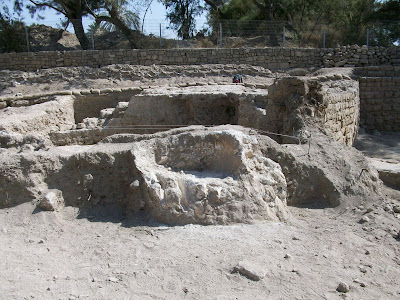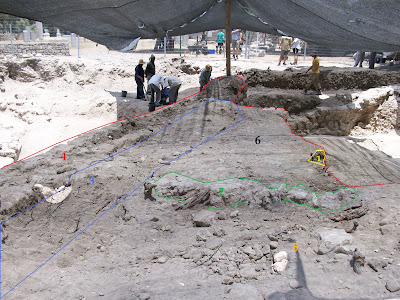In general, the first week of an archaeological excavation is a slow one. It always takes a day or two to clean up the effects of the off-season, or to clear the surface that's going to be excavated, and it takes a while for people who've never been on a dig to get used to their tools, and waking up at four in the morning, and so on.
And yet, I think we did about as much work as could be expected in a week. I think that we know where the good archaeological contexts are, and where they aren't, and we'll be able to be digging good material starting Monday, if we aren't already in a Crusader period robber trench. So, as far as the digging goes, I'm going to call this week an unmitigated success.
On other fronts, things were a bit more . . . well, mitigated. I've got a somewhat better handle on the computer system than I did at the start, which is good, as I'm going to have to start collecting and sorting more data, as we work through the better archaeological contexts. And, hopefully, managing that stuff is going to take up less of my time. But, as far as the last week goes, I'm going to have to chalk a certain amount of it up to a "learning experience", and spend the next few hours fixing mistakes I made, and getting in information that I've left out.
As far as blogging goes, there are a few things that I wanted to try, the first of which you can see below. I apologize in advance for the sort of
Blair Witch cinematography (do the kids remember the Blair Witch Project? Should I call it
Cloverfield cinematography if I want to be understood by the youth of today? In either case, what I mean is that it's not very good.)
Whatever you want to call it, it's a brief tour of the square, narrated by yours truly:
Another thing that I wanted to do was to keep an eye on what was going on in the other squares; while I'm not planning on trekking out to the other areas, as they're scattered across the tel, I'm hoping to get a picture or two, and a general sense of what's going on in the squares nearby.
So, here's what I've got for the first week:

The square directly to the east of me was the only square open last season, and this week, they've been digging in the western half of their square. Thus far, they've come across a number of different layers of material, but they haven't found any structures or floors, so they're working on figuring out when various layers of material were deposited, and their relationships with each other; a complicated sort of job.
(The picture was taken on day 3; sadly, it seems that's the best picture that I've got of their square.)
There's one other square open in our area, directly to the north of this one, and to the northeast of mine.

For the moment, this square is defined by the trench that Garstang dug, and which the JCB redug. (It does seem that the JCB may have cut a bit more than Garstang, but such is the way of excavating equipment.) One of the structures they've turned up, on the southern side of that trench, is this large, plaster lined pit. It seems to have been poured, rather than free-standing, because the plaster walls are not strong enough to have stood on their own -- someone dug a pit, and then poured plaster in to line it. It may have been used as a lime kiln, which may have been where some of the statuary of the basilica were turned to lime, or it might have been something else.

On the other side of that trench, there had been a floor. That floor was taken out yesterday, and it's not yet clear when that floor is from; hopefully, they'll find good dating evidence in the fill directly below it.
This isn't all they've found -- there are other, subtler features that have turned up on the southern side of this square. But these are the large, dramatic features of which I have pictures.
And that more or less where we're up to, but there's one thing more that I wanted to talk about before closing up shop for the weekend.

You'll remember that sherd from earlier in the week. Yesterday, our pottery expert (who is also the area supervisor) looked at it, along with a great many other sherds, and gave her evaluation; it's a sherd from a glazed bowl, with incised decoration, and dating to the Mamluk period (1250-1517).

The next picture is a closeup; the bit of paper in the background is a top plan -- that's a sort of map, that shows where the dividing lines between the different units are, so we can know exactly where the pottery came from.
Once the pottery was read, that sherd was put aside, along with a lot of similar pieces, for further analysis -- there are some difficulties with the dating of Islamic period sherds, so the plan is to get several experts together, to look at what we come up with this season, and to try to pin down those dates.
And that's more or less it for week 1. I'm not entirely sure what next week is going to look like, but hopefully, I'll be able to do something like this the next time the volunteers are off on a trip somewhere.




